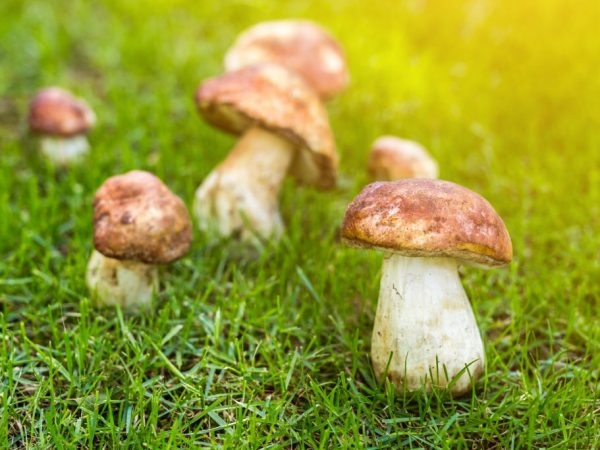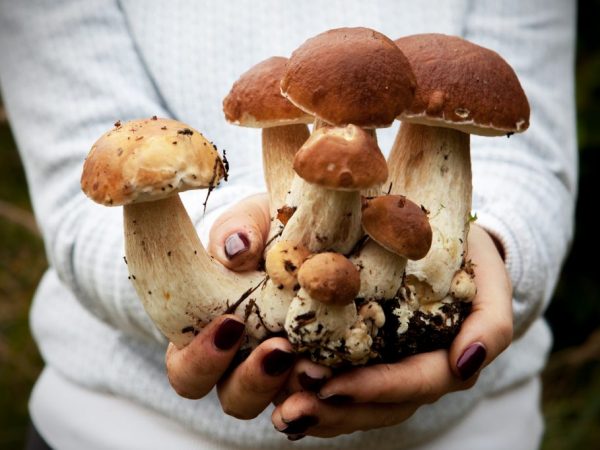Cep cultivation technology
Of all types of mushrooms, the most valuable for the human body are white ones. They are a "storehouse" of nutrients and microelements. To get a fragrant product, today it is not necessary to go to the forest, especially since its reproduction in natural conditions is gradually decreasing. You can grow it yourself. Growing porcini mushrooms at home does not take much time. The crop is harvested three times a year.

Cep cultivation technology
Features of growing porcini mushrooms
Boletus grows well under certain conditions. When growing them, it should be possible to regulate the temperature and humidity of the air. This is done in a greenhouse or a room specially equipped for this purpose with air conditioning and heating systems. The place should also be equipped with daylight lamps. To save space, racks are installed in the greenhouse.
It is not difficult to grow porcini mushrooms in the basement as well. But on a balcony, in a loggia or an apartment, this is almost impossible to achieve. In these premises, conditions are very different from the natural habitat of boletus. They do not grow when the air humidity is less than 60%, so you will have to completely change the microclimate of the room or allocate a separate room for this purpose.
If possible, boletus are created conditions that are as similar as possible to their natural habitat. In nature, they grow near birches, oaks, aspens and conifers, and where there is moss litter. It is unlikely that it will be possible to create a coniferous grove or pine forest on a personal plot, and planting a decorative spruce that will decorate the garden is a doable task. In addition, the resin secreted by conifers acts as an antiseptic for the soil, destroying pathogenic bacteria.
But even the presence of conifers will not save the harvest in a dry summer, so you should give preference to methods designed to grow porcini mushrooms indoors.
Preparation of premises and soil
In order to grow many porcini mushrooms at home, it is important to properly prepare the soil and the room.
Premises preparation
When it comes to growing in a greenhouse, it does not need to be cooked in a special way. It is enough to install the equipment necessary to maintain a certain level of humidity and temperature conditions, equip the greenhouse with special fluorescent lamps. Basements, in which experts recommend growing boletus, are prepared more carefully.
The best option is to concrete all surfaces, including the ceiling. Then the walls should be whitewashed. Whitewashing is a good antiseptic. The introduction of copper sulfate into the whitewash solution will significantly enhance the antiseptic effect.At the next stage, the room is equipped with a ventilation system, devices for maintaining the temperature at 13 ° C, fluorescent lamps, racks and equipment that allows you to adjust the air humidity in the mushrooms necessary for successful cultivation.
Irina Selyutina (Biologist):
Although the incubation period (the development of mycelium) in boletus can pass absolutely without any problems without light, but as soon as the first caps of the fruiting bodies "cut through" to the surface of the substrate, they will need at least 5 hours of daily illumination.
Attention! The optimum moisture content for boletus is 80-90%.
Soil preparation
Growing porcini mushrooms in the country and indoors will give the desired result only if the soil is properly prepared. In specialized stores there are ready-made substrates for growing mushrooms. However, when buying them, you cannot be sure of its quality. It is better to prepare a fertile substrate for boletus by yourself - here you will already be sure of the quality.
A suitable substrate for growing a porcini mushroom house consists of dried birch, aspen or oak leaves, acorns, coniferous twigs, dried field grass, moss, sand and clay. For 4 parts of sand, take 1 part of dry clay. Also, hay and sawdust in small quantities is added to the substrate if desired.
Before mixing all the components of the substrate, grass, bark, sawdust and other similar components are washed and dried. the finished substrate is left to infuse for 2 weeks in a dry and warm room.
Preparation of planting material
Porcini mushrooms do not reproduce by seeds, but by spores. Planting material for growing porcini mushrooms is obtained in different ways. There is a ready-made mycelium, suitable both for growing in a personal plot or summer cottage, as well as under a cover. On the package with it there is an instruction in which it is described in detail how this material should be planted.

It is advisable to prepare planting material from healthy mushrooms.
To prepare planting material with your own hands, you will need a formed boletus. It is advisable to use healthy mushrooms, although those whose leg has already begun to deteriorate will do. It is very important that the hat is intact, because it is in it that the formation and development of spores takes place. Each of the following preparation methods is equally effective:
- Forest, wild-growing mycelium: part of it is simply transferred from the forest to a previously prepared substrate. When transplanting mycelium into open ground, take the one that grows near the same trees that are on the garden plot. If the mycelium grew in a pine forest, it is planted near a pine tree. This significantly increases the likelihood of mycelium survival in the country. For this type of planting, it is important to take a layer of starting material of at least 15x15 cm.It can be planted in one piece, or it can be divided into at least 5x5 cm pieces.
- "Garden method": suitable for growing porcini mushrooms in the garden. The collected porcini mushrooms are finely chopped. A hole is dug near the tree, where planting material is put, then they are buried and poured with 4 buckets of water. The harvest will appear in a year.
- Boletus caps separated from the legs:
Option 1: to prepare planting material, they are crushed using a meat grinder or knife. Then it is poured with a weak solution of potassium permanganate with sugar and left for 4 hours. To prepare the solution, you will need 10 liters of water, 1 g of potassium permanganate and 5 tsp. Sahara. The resulting mixture contains boletus spores. Some gardeners use all the resulting solution, and some filter it through cheesecloth and plant what remains in it.
Option 2: porcini mushrooms collected in the forest, clean and separate the legs from the caps. The hats are soaked for a day in spring or rain water. Then knead or grind through a sieve, filter through cheesecloth. The gruel remaining in the gauze is the planting material.
Planting and growing porcini mushrooms
Planting boletus at home does not take much time.
Planting boletus
If boletus is grown on a garden plot without a covering or in a greenhouse, then the first step is to remove the top layer of soil (0.3-0.4 m) on an area of about 3 m2... Then the prepared substrate is laid and the planting material is spread over it. It remains to sprinkle the solution from the seeds (spores) of boletus with a thin layer of substrate (no more than 4 cm).
Irina Selyutina (Biologist):
Here's another, similar way, how you can lay a mushroom bed on the site:
- Remove all weeds in a well-sunlit area close to the appropriate tree species and begin to moisten the soil about a month before the mycelium is planted.
- Take care of harvesting dry leaves and tree bark.
- Dig a hole 30 cm deep and 3 m in area2.
- Mix the earth thoroughly with humus.
- Scatter dry leaves and bark at the bottom of the hole.
- Pour the seed into a small amount of sand, mix and spread it evenly around the perimeter of the pit.
- Then cover with compost, and cover the top with earth.
Consider. Boletus loves moisture, but does not like waterlogging. Therefore, it is better to water the soil as it dries up and it is better to use an irrigation system.
For the winter, the planting site must be covered with hay or dry leaves.
It is best to do planting in open ground in the spring, then you will receive the first harvest in the fall, and not the next year, as it will be with the autumn planting. In one place, the mycelium will bear fruit for 5-7 years.
When disembarking indoors, containers are first prepared. Any container, convenient to use, will do. A drainage layer is laid on the bottom, 40 cm of the substrate, planting material, again 3-4 cm of the substrate. The optimum air temperature for planting in a garden or indoors is 27 ° C.
Mushroom Care and Harvesting
The first white mushroom planted at home will appear in 8 days. In general, boletus grows quickly. The first crop is ready for harvest 23 days after planting. From the moment of planting to the appearance of the first boletus on the site or in the container, the temperature and humidity of the air must remain unchanged, for this the soil is moistened daily. The room is ventilated in the morning and in the evening.
White boletus loves light. Artificial lighting is turned on for 8-10 hours. If boletus is grown in a greenhouse, they are still illuminated with fluorescent lamps. The time the sun shines is not enough.
After the appearance of the first shoots, the air temperature is lowered to 16 ° C.
Boletus mushrooms bear fruit for 43 days. The time between the first and second harvest is 11 days on average.
To avoid problems with re-fruiting, you should not cut off the grown boletus with a knife. They are twisted with neat, smooth movements, and the empty hole is sprinkled with a substrate so that the exposed filaments of mycelium do not dry out. After a while, a new mushroom will appear in this one.
Conclusion
Following simple rules, during one fruiting in a medium-sized plot, it will be possible to collect up to 20 kg of large boletus. Indoors, myceliums bear fruit all year round. In the industrial cultivation of porcini mushrooms, the so-called. "Dutch technology". It involves the use of compost, which consists of manure, hay and various organic additives. This technology is also applicable for home cultivation. However, on a local scale, the cost of boletus will be high.



